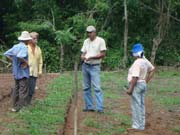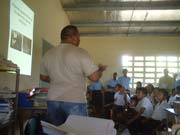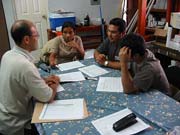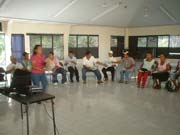- Home
- Technical Cooperation Projects
- Index of Countries
- Latin America
- Panama
- Project for Participatory Community Development and Integrated Management of the Alhajuela Lake Subwatershed
- Project News
- Technical Transfer of "Environmental Education" to C/P
Project News
2009-11-25
Technical Transfer of "Environmental Education" to C/P
Is it possible to achieve rural development and watershed conservation at the same time? Even though we may encourage inhabitants to conserve the water, soil, forest and wildlife, if such conservation activities mean (or at least creates the perception) that the inhabitants would lose their means of sustenance or that they would have to do more work to achieve the same results as always, then it will be unlikely that they would do conservation activities. Thus, “environmental education” activities have this old, yet at the same time, new dilemma that needs to be overcome through consistent effort that brings about a change in people’s awareness.
The first issue for technical transfer of environmental education was to introduce concrete activities aimed at “awareness creation among adults”. Additionally, we promoted environmental education activities for children, which is an area that the Panamanian C/P’s are strong in. In order to promote environmental conservation, which could be perceived by inhabitants as a restraint to their farming activities, one needs to have the ability to repeatedly go in front of people and explain to them the need for conservation, using successful examples of alternative practices, without fearing being rejected by them.


(Photo 1, left) The extension worker Mr. Aris Escobar explains the use of worm fertilizer to students from the San Juan de Pequeni elementary school. (June 2, 2009)
(Photo 2, right) The extension worker Mr. Jose Carrion (center) explains the importance of agricultural conservation to group members during an educational tour. (June 3, 2009)
The second issue is to establish the habit of measuring and recording the results of conservation activities. Of course, it is important to also record the number of activities and the number of participants. However, the purpose of environmental education and awareness creation is to change the attitude and action of the inhabitants. Therefore, a way is needed to show how such changes are occurring in people. Currently the Project is using questionnaires and surveys of participants to accomplish this end.


(Photo 3, left) After awareness creation activities, the C/P Ms. Ednadeliz Flores (third from left) distributes a questionnaire among participants. (May 19, 2009)
(Photo 4, right) The activities are always repeated in order for the techniques to be adopted. (October 13, 2009)
Technical transfer of environmental education is not the responsibility of only the C/P Ednadeliz, in charge of environmental education. We are currently working so that the members of the technical extension component and of participatory development component also contribute to this activity. The C/P’s are still at a midway point in their mastery of this activity, but we continue to give them all the support necessary.
(Mr. Taku MORI, Farmland Use Plan / Extension)
